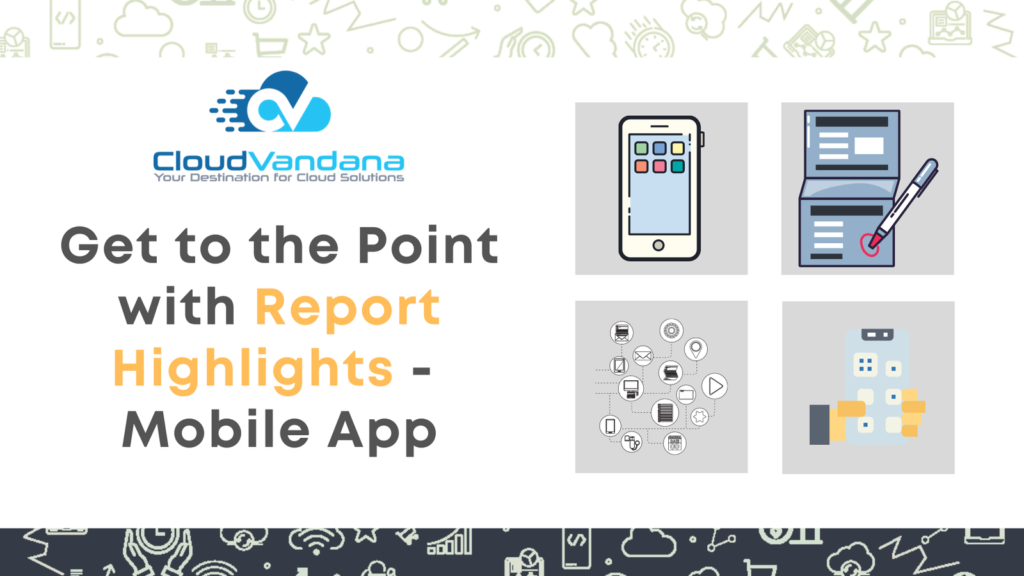Get to the Point with Report Highlights-Salesforce Mobile App

Explore how Salesforce Mobile App empowers teams with real-time access to CRM data, actionable insights, and streamlined workflows—anytime, anywhere. Boost productivity and decision-making on the go. In today’s velocity-driven business climate, executives, managers, and field teams can no longer afford to dig through spreadsheets or dashboards for critical information. Decision-making often happens between meetings, in transit, or mid-call. The mobile revolution in enterprise systems hasn’t just changed how work is done—it’s reshaped how insights need to be delivered. Salesforce’s Report Highlights in the mobile app represent a seismic shift in how business intelligence travels. It’s not about replacing full dashboards. It’s about distilling the signal from the noise—surfacing only what demands immediate attention. Let’s unpack what Report Highlights are, why they matter, and how to implement them effectively. Table of Contents What Are Report Highlights in Salesforce? The Purpose Behind Report Highlights Evolution of Mobile Reporting in Salesforce When to Use Report Highlights Where to Find Report Highlights Key Metrics Ideal for Report Highlights Creating Report Highlights in Salesforce Supported Report Types for Highlights Limitations to Consider How to Enable Highlights for Mobile Designing for Mobile Attention Real-World Use Case #1: Sales Leaders on the Move Real-World Use Case #2: Support Managers Real-World Use Case #3: Executive Stakeholders Governance Best Practices Performance Optimization for Mobile Security Considerations What’s Next: The Roadmap for Report Highlights Conclusion YOU MIGHT ALSO LIKE What Are Report Highlights in Salesforce? Report Highlights are compact, visually prominent metrics that appear at the top of a report in the Salesforce Mobile App. They’re designed to summarize key data points—typically one to three numerical fields that capture performance at a glance. Unlike traditional charts or dashboards, these highlights are unobtrusive yet impossible to ignore. They live right where users need them—above the fold, inside reports viewed on mobile. The Purpose Behind Report Highlights The core philosophy is simple: speed-to-insight. Highlights help users skip the interpretive work and instantly grasp what matters—sales figures, support loads, revenue deltas, case aging—without navigating tabs, filters, or charts. For executives, it means fewer dashboards. For reps, it means one-touch access to targets. For managers, it means agility in decision-making. And in all cases, it means better focus. Evolution of Mobile Reporting in Salesforce Salesforce has been steadily evolving toward mobile-optimized intelligence. What began as simple report views has matured into fully responsive dashboards and now purpose-built highlights. The rollout of Lightning Experience paved the way, but the real inflection point came when highlights became native to the mobile experience—no additional development required. When to Use Report Highlights Highlights aren’t for all data—they’re for mission-critical metrics. If it can change how someone acts in the next 5 minutes, it’s a candidate for a highlight. Report Highlights are not intended for every type of data. They are best reserved for metrics that are mission-critical—those that demand immediate awareness and drive real-time decisions. For instance, in the context of field service, these highlights can display the number of open work orders, enabling supervisors and technicians to prioritize resources efficiently. Sales managers can benefit from highlights that reflect key performance indicators such as quota attainment or daily bookings, helping them stay on top of targets without needing to dig through complex dashboards. Similarly, customer satisfaction teams can monitor performance with metrics like the average CSAT (Customer Satisfaction Score) or the number of survey completions. These indicators allow quick interventions when satisfaction dips. In sales operations, the highlights can summarize opportunity pipeline metrics—such as deals closing this week or forecast accuracy—giving teams a clear sense of urgency and alignment with quarterly goals. In each scenario, Report Highlights become a lightweight yet powerful lens for strategic decision-making. Where to Find Report Highlights Users can access highlights in: They appear at the top of the report before any rows or charts—no scrolling required. Users can access Report Highlights in several key areas within the Salesforce mobile experience. The most direct route is through the Reports tab, which is optimized for mobile and presents highlights at the top of each applicable report. These summaries provide instant context before a user even scrolls through detailed data rows. Additionally, custom Lightning Pages that include report components can be configured to display highlights natively on mobile devices. App-specific tabs, which can be prioritized through mobile navigation menus, also serve as effective locations to surface these KPI summaries. In each case, Salesforce ensures that the information appears prominently—immediately visible when a report is accessed on the mobile app, without requiring any additional taps or navigation. Key Metrics Ideal for Report Highlights Report highlights shine when they show trend-sensitive metrics like: Each of these gives a pulse reading—what’s working, what’s not, and what’s urgent. Creating Report Highlights in Salesforce To build highlights: Once saved, these highlights are automatically surfaced on mobile. Supported Report Types for Highlights Highlights work best on: They do not currently work with: Choosing the right report type is foundational. Limitations to Consider No feature is without trade-offs. Highlights: Still, the value they bring for top-line awareness is enormous. How to Enable Highlights for Mobile Admins should ensure: This is a configuration task—not development work. Designing for Mobile Attention The small screen forces clarity. Highlights should: Design with distraction in mind—every pixel matters. Real-World Use Case #1: Sales Leaders on the Move A VP of Sales walks into a weekly pipeline meeting and, with two taps, sees: That’s all it takes to guide the meeting—not a single spreadsheet involved. Real-World Use Case #2: Support Managers A Support Director reviewing highlights at 9 AM can view: With that, they know where to focus resources for the day. Real-World Use Case #3: Executive Stakeholders Boardroom dashboards are overkill for executives. Report highlights inside the mobile app offer: No need to wait for a BI team to prepare slides. Governance Best Practices Admins and analysts must establish: Metrics without context or governance are dangerous. Performance Optimization for Mobile Fast-loading highlights require: Lightweight reports lead to lightning-fast insights. Security Considerations Report highlights obey: Ensure that KPI






